Jean Picart le Doux
Jean Picart le Doux playing cards, issued in 1957 to celebrate the company's 125th anniversary, featuring designs carried out in richly toned colourings typical of tapestries.
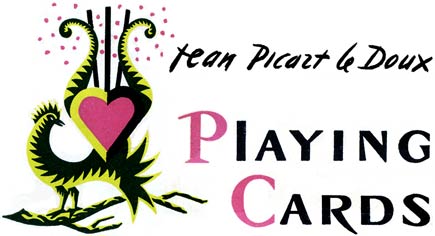
Jean Picart le Doux
Thomas De La Rue and Company
Issued in 1957 on the occasion of the First International Playing Card Week, hosted by De la Rue in London to celebrate the company's 125th anniversary. Artists from several countries had been invited to submit designs for new court cards. Those submitted by Jean Picart le Doux, the famous French tapestry designer, were chosen as the most attractive and outstanding. The set features designs carried out in richly toned colourings typical of the tapestries which Picart le Doux designed for Aubusson & Gobelins. The box (detail shown left) bears a version of the Ace of Hearts which takes the form of a Love Bird. The court cards of the Spades Suit are inspired by maritime ideas and have a recurring theme of the trident. Star fish decorate their clothes. The Ace of Spades is formed by two dolphins supporting the trident with their tails.
One of the striking features of the pack is the interesting treatment of the index figures showing the value of the cards and the carefully conceived layout of the suit symbols. Picart le Doux playing cards were first offered for sale through retail stores at 25 shillings per double pack from 8th October 1957.
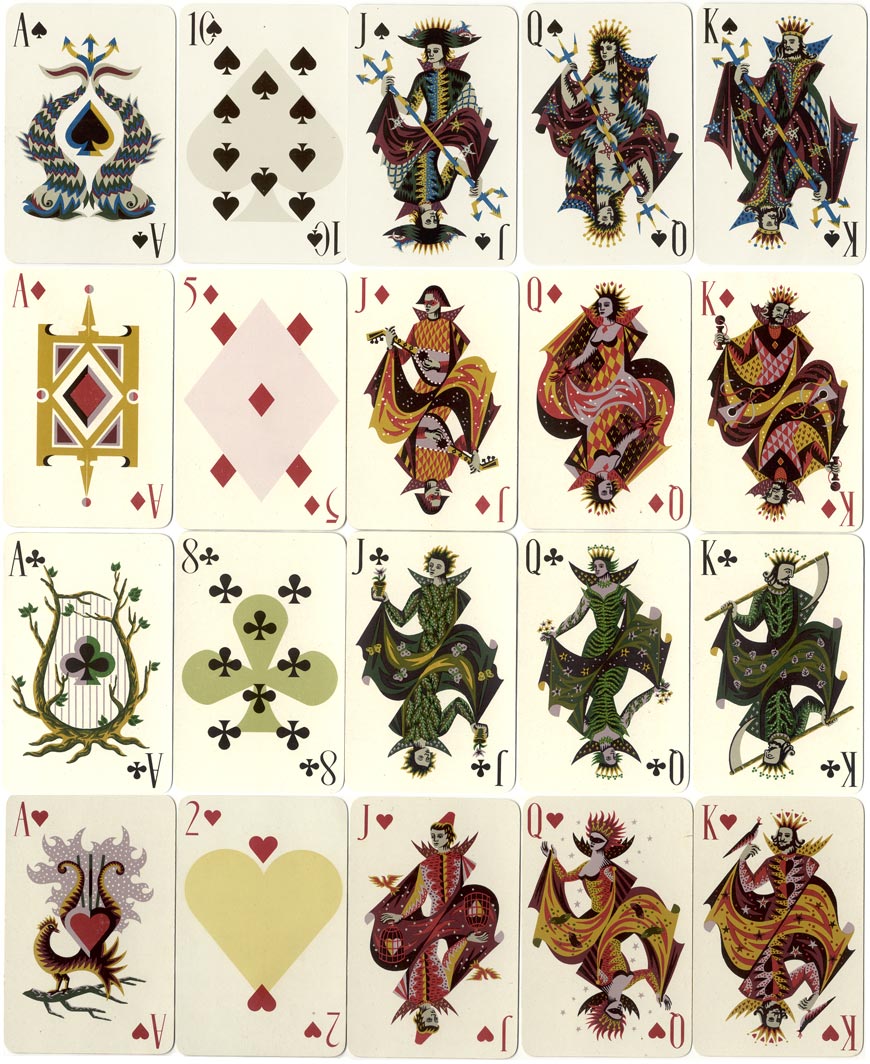
Above: Playing cards specially designed by Jean Picart le Doux for Thomas De La Rue and Company's 125th anniversary, 1957. The card faces are printed in fourteen different colours; the backs in four colours. The carefully conceived layout of the suit symbols gives the cards an appearance of supreme elegance and charm. The Diamonds suit cards are inspired by the troubadours and other characters of mediaeval romance: the masked knave is shown playing a lute. For the court cards of the Club suit Picart le Doux has sought his inspiration in scenes of the countryside. The King is shown bearing a scythe and flowers; leaves and butterflies are used as decoration on all the court cards. The court cards in the Heart Suit, notable for their grace and flowing lines, are based on portraits of mediaeval fowls. The bird theme which occurs on the Ace of Hearts in the form of a Love Bird bearing an ardent heart on its back is repeated on the King and Knave. The Knave is depicted as holding a cage from which the Love Bird has escaped but which still holds a captive heart.

Above: the Joker, extra card, back designs and the control slip giving De La Rue's address as De La Rue House, 84-86 Regent Street, London W.1. This was De La Rue's office in London; the cards actually would have been printed by Waddington's at 40 Wakefield Road, Leeds 10.
By Simon Wintle
Spain • Member since February 01, 1996 • Contact
I am the founder of The World of Playing Cards (est. 1996), a website dedicated to the history, artistry and cultural significance of playing cards and tarot. Over the years I have researched various areas of the subject, acquired and traded collections and contributed as a committee member of the IPCS and graphics editor of The Playing-Card journal. Having lived in Chile, England, Wales, and now Spain, these experiences have shaped my work and passion for playing cards. Amongst my achievements is producing a limited-edition replica of a 17th-century English pack using woodblocks and stencils—a labour of love. Today, the World of Playing Cards is a global collaborative project, with my son Adam serving as the technical driving force behind its development. His innovative efforts have helped shape the site into the thriving hub it is today. You are warmly invited to become a contributor and share your enthusiasm.

Leave a Reply
Your Name
Just nowRelated Articles
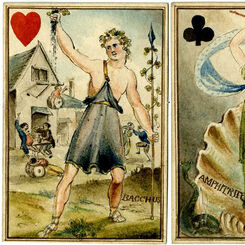
Heathen Divinities
Handmade playing cards from the British Museum depicting classical Greek and Roman gods and goddesse...

59: Owen Jones (1809-74) and De La Rue
A selection of examples of Owen Jones's artwork printed by De La Rue.
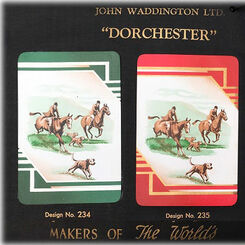
Waddington’s 1940 Trade Brochure
Waddington’s 1940 Trade Brochure.
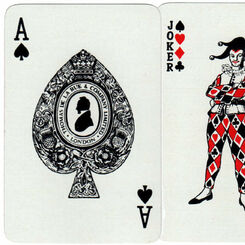
When three brands merge...
After De la Rue factories were bombed in 1940 their cards were printed by Waddingtons. In 1962 Waddi...

Help Yourself Society
The “Help Yourself” Society was formed in 1927 to run fundraising activities for hospitals.
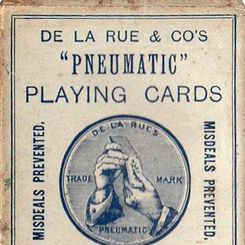
Pneumatic Series ‘F’
De la Rue Pneumatic Series ‘F’ playing cards, c.1925.
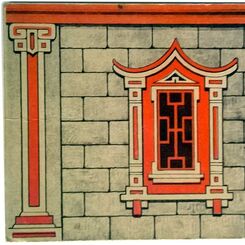
Rūfa
Rūfa is a game designed by Ernest Legh and manufactured by De la Rue. The object is to build a pagod...
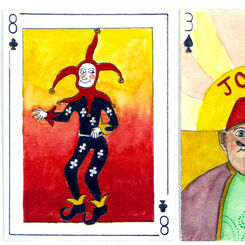
Jest Jokers
Peter Wood’s “Jest Jokers” comprising 54 different Joker designs made into a full pack of cards.

Rufford Playing Cards
Rufford playing cards is one of several brand names used by Boots for their stationery department, a...
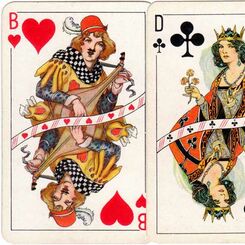
De la Rue for export
Non-standard playing cards produced by De la Rue & Co. (London), c.1930s
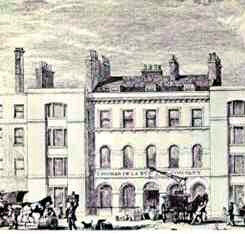
Draughts League Medals
Arthur Charles Prince worked for De la Rue as a playing card cutter and later was promoted to superv...
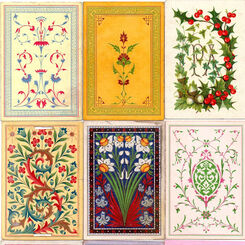
14: Back Designs
A few examples of the many interesting back designs.

5: De La Rue
In December 1831 Thomas de la Rue was granted his patent for printing playing cards by letterpress.

De La Rue
De La Rue introduced letter-press printing into playing card production and his patent was granted i...

About Peter Wood
Peter Wood is a UK based artist.

About Shelley Fowles
Shelley Fowles was born in South Africa but has lived in the United Kingdom since 1979. She trained ...

Amalgamated Playing Card Co., Ltd
Agreement had been reached between Waddington's and De La Rue during the second world war for Waddin...

Owen Jones (1809-1874)
Owen Jones (1809-1874) was a Welsh architect and interior designer who designed the backs of playing...

Romanian playing cards by Alf Cooke
Romanian playing cards, manufactured and exported by the Universal Playing Card Co., Leeds, in the 1...

2000Pips Transformation Pack
2000Pips Transformation Pack
Most Popular
Our top articles from the past 60 days


 Your comment here. Your comment here. Your comment here. Your comment here. Your comment here. Your comment here. Your comment here. Your comment here. Your comment here. Your comment here. Your comment here. Your comment here. Your comment here. Your comment here. Your comment here. Your comment here. Your comment here. Your comment here. Your comment here. Your comment here. Your comment here. Your comment here. Your comment here. Your comment here. Your comment here. Your comment here. Your comment here. Your comment here. Your comment here. Your comment here. Your comment here. Your comment here.
Your comment here. Your comment here. Your comment here. Your comment here. Your comment here. Your comment here. Your comment here. Your comment here. Your comment here. Your comment here. Your comment here. Your comment here. Your comment here. Your comment here. Your comment here. Your comment here. Your comment here. Your comment here. Your comment here. Your comment here. Your comment here. Your comment here. Your comment here. Your comment here. Your comment here. Your comment here. Your comment here. Your comment here. Your comment here. Your comment here. Your comment here. Your comment here.




















